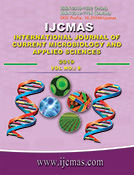


 National Academy of Agricultural Sciences (NAAS)
National Academy of Agricultural Sciences (NAAS)

|
PRINT ISSN : 2319-7692
Online ISSN : 2319-7706 Issues : 12 per year Publisher : Excellent Publishers Email : editorijcmas@gmail.com / submit@ijcmas.com Editor-in-chief: Dr.M.Prakash Index Copernicus ICV 2018: 95.39 NAAS RATING 2020: 5.38 |
Composting is carried out under aerobic thermogenesis to prepare a selective substrate for Agaricus bisporus production. Conventionally, wheat straw based synthetic compost is used for its production. Use of paddy straw as such tends to make the composting process anaerobic leading to low quality compost and low yields. In the present study, an alternative high yielding compost formulation based on paddy straw + maize stalks as a substitute to the existing wheat straw based compost has been made. The physicochemical characteristics of the composts revealed their moisture, pH, temperature, C:N ratio to be within the range of 58.7-67.3%, 6.4-7.9, 42.1-76.4°C,37.7:1-16.6:1 respectively. During different stages of mushroom cultivation i.e. at zero day of compost, final grade compost, pin head stage, after first flush and at crop termination the straw was analysed for proximate composition. NDF, ADF, Cellulose and hemicellulose content was significantly reduced upto pin head stage and ranged from (70.20-46.20%), (52.41-33.72%), (36.37-20.69%), (17.59-8.57%) respectively and stable thereafter in all the compost. Total ash content showed increment and ranged from 10.90-21.37%. There was no decline in the lignin content during different stages of composting and crop production. Yield data indicated maximum yield (13.6 kg/q compost) in paddy straw + maize stalk (1:1) compost with 1563 fruit bodies/ q compost. It was observed that paddy straw + maize (1:1, w/w) compost was better degraded than paddy straw + maize stalk (2:1, w/w) and paddy straw composts. From the recent study, it was concluded that paddy straw + maize stalk (1:1, w/w) compost was the best formulation which could be further exploited for large scale production of mushrooms for small and marginal farmers.
 |
 |
 |
 |
 |